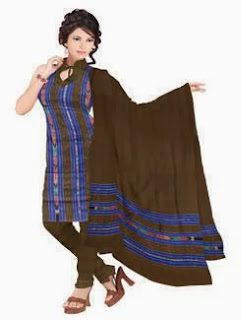Pochampally is
located in Andhra Pradesh, India, is well-known for its Pochampally brand offabrics, being cotton, silk or a combination of the two. Pochampally cottons
are woven by the ikkat technique. Ikat, or Ikkat, is a dyeing technique
wherein bindings or substances resisting dye penetration are applied over the
fibres in pre-determined patterns and then the threads are dyed. Alteration of
bindings and using more than one colour for dyeing produces multi-coloured
thread effect. Removal of the bindings and the subsequent weaving of the threads
would form the desired pattern woven in the fabric.
The determining
characteristic of ikat is the dyeing of patterns, by means of bindings, on the
threads prior to the weaving of the fabric. More the precision in the
application of the resist bindings, finer would be the pattern formed. Ikkat is
classified into single-ikkat and double-ikat styles. Pochampally cottons come
in a wide range of colours and with unique patterns. The artistic excellence of
ikat prints can be gauged from its traditional motifs of flowers, dancing girl,
creepers, leafs, parrot, animals, birds, mythological characters and
geometrical patterns. Most of the ikkat printed salwar kameez and sarees have
repeated geometrical patterns of diamonds (rattan chowk), circles, squares, lines
etc.
Unnati has a
unique range of fusion salwar kameez where trending designs, patterns and
colours have been incorporated in traditional styles of fabric making, and
available in retail and wholesale. Examples of offerings are provided. The
black and light grey with green Pochampally cotton salwar kameez has alternateblack and light grey horizontal bands with zari embroidered buttis and a greenpatch border on the kameez. The plain green cotton salwar is a fitting
contrast. The green silk chunni has a white floral embroidered border and black
horizontal stripes on it. This pleasant piece would do for office, festivals,
social events and even casual outings.
The Ikkat technique
involves applying bindings which resist dye penetration to the threads in pre-determined
patterns and then dyeing the threads. These threads are then woven to produce
the desired pattern. When several colours are used, the dyeing process on the
threads is repeated for each of the colours chosen. Then the fabric is wovenwith the multi-coloured threads into the pattern. Within the ikkat style of
dyeing are variants of single-ikkat and double-ikkat.The tie-dye method is
quite the reverse of the Ikkat style of dyeing. Here the threads are first
woven and the resist bindings then applied to the fabric before dyeing it.
The painstaking efforts
of the weavers in maintaining the purity of dyeing and weaving, contribute
largely to the uniqueness and pleasing appearance of the dress. Current trends
see Pochampally cotton dresses with traditional designs, zari borders and
elegant dupatta - a must-buy for
festivals, traditional functions and even corporate wear.
Unnati silks, the largest ethnic online Indian shop offers exquisite designer Kota Cotton sarees with matching blouse for online sale. Our Online shopping store has the widest range of ethnic Indian Sarees and Salwar Kameez. At Unnati Silks, you can buy unique, exclusive collection at affordable prices.You can purchase online at Unnati silks and the products will be dispatched within 24 working hours of placing the order. We have Free shipping and Cash on Delivery (COD) facility for Hyderabad, Mumbai, Bangalore, Kolkata, Chennai, Ernakulum, Delhi, Chandigarh, Lucknow, Patna, Jaipur and many other Indian cities. We also do Worldwide express shipping to countries like United States of America (USA), United Kingdom (UK), UAE, Dubai, Oman, Pakistan, Singapore, Malaysia, Australia, Canada, Chicago, New Zealand and others.
Contact:
UNNATI SILK PRINTS PVT. LTD,#3-4-360, Vajra Complex, General Bazar (Tobacco Bazar), M.G.Road, Hyderabad-500003.AP,India.040-64555251 or 97000 57744.
www.unnatisilks.com
You can also buy online sarees in




No comments:
Post a Comment
Note: only a member of this blog may post a comment.